Citizen Science Symposium: Celebrating the Public Participant in Research
Posted in Humanities Institute on April 29 2019, by Samantha D’Acunto
Samantha D’Acunto is the Reference Librarian at The New York Botanical Garden‘s LuEsther T. Mertz Library.
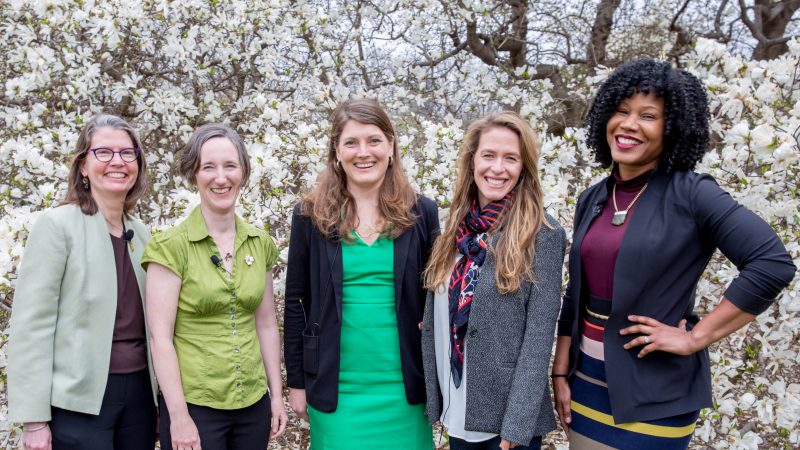
On Friday, April 12, 2019, the Humanities Institute, in collaboration with NYBG’s Horticulture and Living Collections and the Center for Conservation Strategy, presented the symposium Nature at Your Doorstep, celebrating the public participant in nature research. The symposium, featuring five energetic experts, officially opened National Citizen Science Day at The New York Botanical Garden, with programs and garden-wide activities extending throughout the weekend.
The Garden’s CEO and President, Carrie Rebora Barratt, welcomed the audience, stating that citizen scientists have been indispensable to scientific research in the past, but especially today, at a time when documenting our planet’s biodiversity is more important than ever. She explained that the creation of The New York Botanical Garden and its programs of study helped lay the foundation of the field of ecology in America. She continued to say that increased public engagement encourages the establishment of new communities who now address broader environmental science and humanities concerns. It all started with computer networks and a handheld tool: the cell phone, she said, pointing to iNaturalist, an online social network of citizen scientists sharing observations of plants across the globe. She ended her welcome speech by looking to the future, predicting how technological innovations in Artificial Intelligence will catalyze greater engagement of the public. She then thanked The Andrew W. Mellon Foundation for its support, which stimulates important cross-disciplinary programs such as this symposium at the Garden
Brian Boom, Vice President for Conservation Strategy at NYBG and moderator for the morning’s program, then stepped forward to introduce the guest speakers.
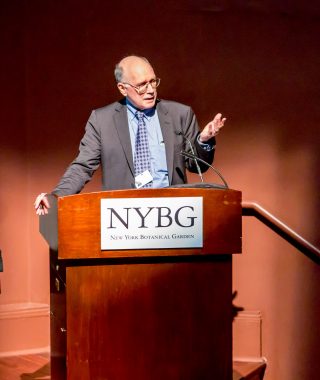
In order of speaking, they were: Sara Tjossem, Senior Lecturer, Center for Science and Society, Columbia University, with “Putting Principles into Play: Linking Universities, Communities and Citizens Through Science;” Majora Carter, President of Majora Carter Group LLC, Founder of Sustainable South Bronx, with “Community as Corporation: Talent Retention Strategies for Low-status Communities;” Kerissa Battle, Community Greenways Collaborative, with “The New York Phenology Project: Documenting Two Centuries of Phenological Change Through Citizen Science;” Carrie Seltzer, Stakeholder Engagement Strategist, iNaturalist, with “Exploring Biodiversity with Crowdsourcing & Artificial Intelligence;” and Jessica Schuler, Director of the Thain Family Forest, NYBG, with “Translating Ecology through Citizen Science.”
First to the stage was Sara Tjossem, whose research is focused on ecology and its intersections with social movements. Pointing at the deep history of public engagement, she gave examples of a few of the nation’s longest-running community science projects, from the Audubon Society’s Christmas Bird Count to Earthwatch, dating back to the 1970s and dedicated to engaging people worldwide in field research. Tjossem explained the way science directly affects society, mentioning environmental policy, the concept of food-farming and sustainability, and the development of modern tools. “The tools of citizen science can have surprising sources,” said Tjossem, amusing the audience. “Pokemon was originally meant to link kids back to the natural world—you can think of that as a failure or a success. But one thing is clear: today’s widely available analytical tools [such as cell phones] have led to a true ‘democratization’ of science, making data understandable to all, providing just another way of looking at the world, and in doing so, improving conservation efforts.”
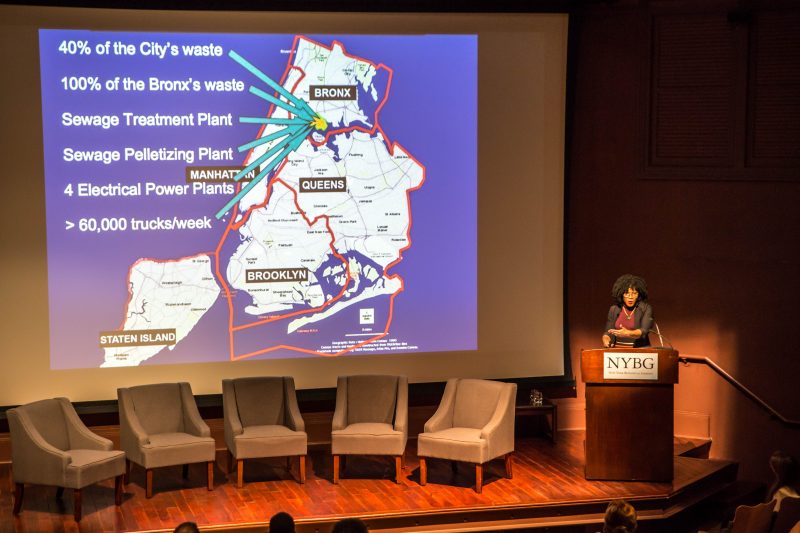
Majora Carter shared similar thoughts on the positive changes brought about through citizen engagement. She recounted the step-by-step reclamation of the South Bronx for its local community, turning around the familiar story of low-income communities experiencing economic stagnation despite governmental and philanthropic support. Carter used the metaphor of people as plants, comparing the South Bronx’s struggling and impoverished communities with fragile and depleted ecosystems. Over time, through successful efforts improving local ecosystems, she was able to help create new communities, reclaiming areas such as Hunts Point along the Bronx River, reseeding it with oyster beds as well as greening the neighborhood. “Public space is the great democratizer,” Carter stated. “Gathering spots are essential to creating new communities, new ecosystems.” Key to the revitalization of the South Bronx was the direct involvement of the residents in the activities in order to create a sense of community, which helps the retention of local talent and diminishes “bright flight.”
Following Carter, Kerissa Battle, an ecologist researching social-ecological connectivity, addressed the audience about the importance of networks and public science for conservation efforts. She gave examples of her work managing the New York Phenology Project, showing the process of engaging citizen scientists across New York State in the creation of a long-term phenological dataset for plants and pollinators of the Northeast. With the help of crowdsourced science, 19th-century data from over 100 locations can now be paired with the modern NYPP data, showing changes in the growing and blooming patterns of many common Northeast plant species.
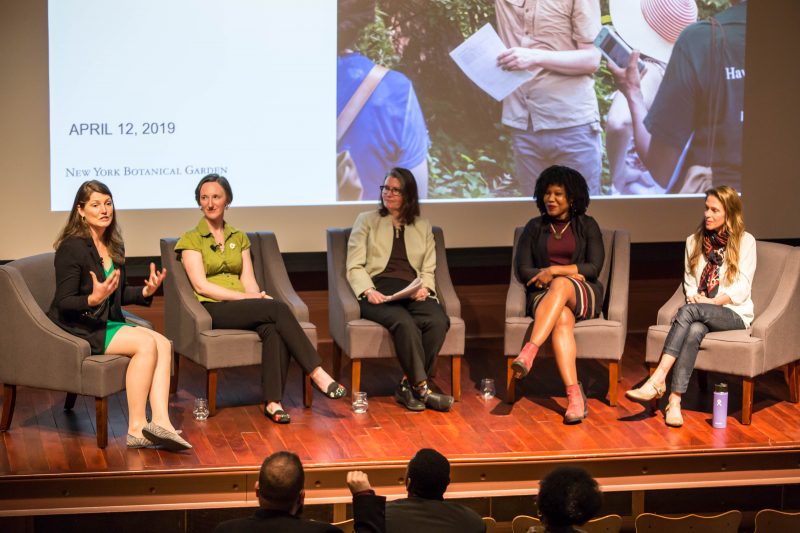
Carrie Seltzer then came to the podium to tell the audience more about nature exploration and data collection through iNaturalist, currently the most popular nature app that helps to identify the plants and animals around us. Explaining how she facilitates partnerships to expand the reach and use of iNaturalist for nature exploration and conservation, she asked the audience for a show of hands, which, to everyone’s delight, proved that almost all present use the app already. “The biodiversity data you gather with your cell phone is very important and expands our knowledge of plant ranges, invasive species, and much more,” Seltzer said.
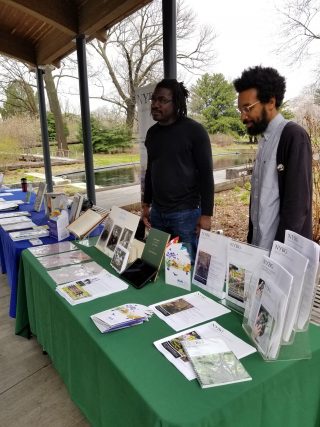
Jessica Schuler, Director of the Thain Family Forest, closed the morning’s presentations, bringing home the various themes by showing how ecology is translated today through citizen science at NYBG. She then invited all speakers to come to the podium for what was a very lively, informative discussion with the audience, ranging from questions about nature conservation and community building to the future of computational software and Big Data.
While each of the five speakers showed various approaches to environmental scholarship, their message was the same: each conversation pointed at the remarkable “democratization” of today’s science, showing the increased engagement of diverse racial and social groups locally, nationally, and globally. Each visitor was encouraged to participate, contribute pictures using iNaturalist, and think critically about the urgency of conservation action. Being a citizen scientist, or “community scientist” as some prefer to call it, does not only impact one’s own neighborhood, but conservation efforts nationwide, ultimately affecting all life on Earth. As one of the speakers admonished: “Let’s take it all a step further and make Nature at our Doorstep into Nature Is our Doorstep!”

